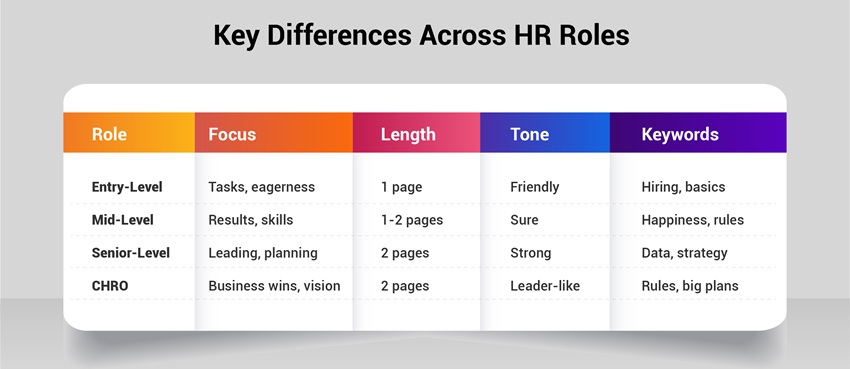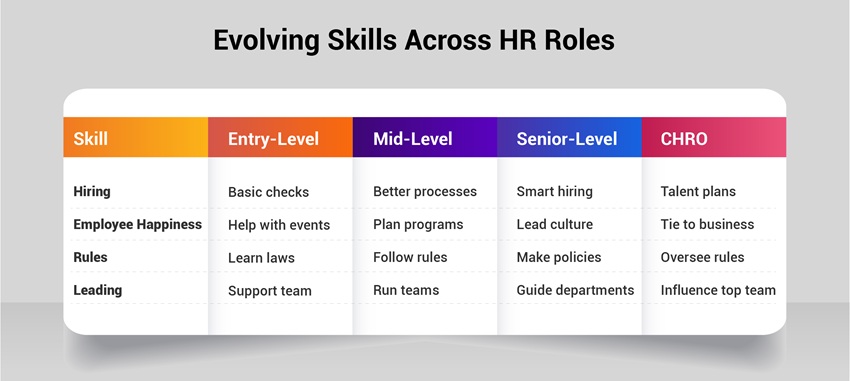Crafting HR Resumes: From Entry-Level to CHRO Success
October 22, 2025

Starting a career in HR is a fun journey, and your HR resume is your way to get new opportunities at every step. Whether you’re just beginning with an entry-level job or dreaming of becoming a CHRO, your resume needs to grow with you. It should show your skills, experience, and goals, starting with simple recruitment skills and moving to big leadership roles. This article looks at how to adjust your HR resume as you move from entry-level to CHRO, with easy tips and examples to help you shine.
Why HR Resumes Need to Change
An HR resume is more than a list of jobs; it tells the story of how you’ve grown in HR. At the start, bosses want to see basic skills like hiring people and doing simple HR tasks. As you move to mid-level jobs, they look for proof you’ve made a difference, like better employee happiness. When you reach CHRO, they care about big leadership and clear business results. Making your resume fit for each job helps you match what employers want, giving you a better shot at getting hired.
The CHRO job needs a mix of HR know-how, managing people, and a smart vision. A basic resume won’t work. Instead, it should focus on your wins, leadership, and how you help the business. Let’s see how your HR resume should change for each role, with examples to guide you.
Entry-Level HR Resume: Starting Strong
At the entry level, you’re new to HR, maybe working as an HR assistant or recruiter. Your HR resume should show you’re eager to learn, have basic skills, and any experience, even from internships or part-time work.
Key Parts:
-
Objective: A simple goal showing you want to work in HR. Example: “Looking for an entry-level HR job to use my hiring skills and help employees.”
-
Skills: List easy skills like data entry, hiring, and using Microsoft Office. Example: “Good at using hiring software and basic HR tasks.”
-
Experience: Talk about simple tasks like setting up interviews or helping new hires. Example: “Helped hire by checking 50+ candidates for internships.”
Tips: Keep it short, one page, and use words like “helped” or “supported.” If you don’t have much experience, add volunteer work or school projects about HR.
Sample Entry-Level Resume Snippet:
Jane Smith
HR Assistant Intern, XYZ Company, 2024
-
Helped the hiring team set up 30+ interviews each month.
-
Kept employee files 100% correct using HR software.
-
Supported 20 new hires with welcome materials.
This shows you’re ready to learn and grow, which is perfect for starting out.
Mid-Level HR Resume: Showing What You’ve Done
After 2-5 years, you might move to jobs like HR manager or specialist. Your HR resume should switch from tasks to results, proving you can handle hiring, employee issues, and rules.
Key Parts:
-
Summary: A quick look at your experience and skills. Example: “Careful HR Manager with 3 years of hiring and employee happiness experience.”
-
Achievements: Use numbers to show your impact. Example: “Made hiring 20% faster with better processes.”
-
Skills: Add bigger skills like managing performance and training. Example: “Good at solving conflicts and making HR rules.”
Tips: Add numbers to your wins (e.g., “lowered turnover by 15%”) and adjust it to fit the job ad. Aim for one or two pages.
Sample Mid-Level Resume Snippet:
Michael Lee
HR Manager, ABC Corp, 2021-2024
-
Led hiring for 50+ jobs, cutting time to hire by 25%.
-
Started training programs, raising employee happiness by 30%.
-
Fixed 10+ employee problems monthly, keeping a good work vibe.
This shows your success, making you stand out for mid-level jobs.
Senior-Level HR Resume: Leading the Way
With 5-10 years of experience, you might aim for senior roles like HR Director. Your HR resume should focus on leading, planning, and helping the business.
Key Parts:
-
Headline: Show what you’re good at. Example: “Senior HR Director – Helping with Talent and Growth.”
-
Achievements: Show big wins. Example: “Planned hiring that filled 100 key jobs in 6 months.”
-
Skills: List leading, managing change, and analyzing. Example: “Great at planning teams and using HR data.”
Tips: Use two pages, add words like “compliance” or “employee happiness,” and use bullets for easy reading. Avoid big blocks of text.
Sample Senior-Level Resume Snippet:
Sarah Johnson
HR Director, DEF Industries, 2018-2023
-
Managed hiring for 200+ people, saving 15% on costs with smart choices.
-
Led changes during a merger, keeping 90% of staff.
-
Made an HR data tool, improving decisions by 40%.
This shows you’re a leader, perfect for senior jobs.
CHRO Resume: Seeing the Big Picture
As a CHRO, you’re a top leader shaping the company’s people plan. Your HR resume should show 10+ years of experience, big influence, and business goals.
Key Parts:
-
Headline: Present yourself as a leader. Example: “Chief Human Resources Officer – Partnering with Business.”
-
Achievements: Focus on business results. Example: “Matched HR plans with business goals, growing revenue by 10% with better talent.”
-
Skills: Highlight big planning, hiring, and rules. Example: “Good at coaching leaders and following ESG rules.”
Tips: Keep it to two pages, use a neat layout with space, and add words like “talent management” or “employee happiness.” Fit it to the company’s needs.
Sample CHRO Resume Snippet:
John Doe
Chief Human Resources Officer, ABC Corporation, 2015-Present
-
Guided hiring plans, adding 300+ leaders, growing the company by 20%.
-
Added ESG rules, boosting reputation and trust.
-
Led changes during growth, keeping 95% of employees.
This shows big leadership, key for CHRO jobs.
Key Differences Across HR Roles
Crafting a resume tailored to your role is essential for standing out in the job market. Below, we outline how focus, length, tone, and keywords vary across entry-level, mid-level, senior-level, and CHRO positions to help you align your application with your career stage.

Each step needs a new focus. Entry-level resumes build trust, while CHRO resumes show a big vision. Changing length, tone, and words keeps it right for the job.
Tips for Crafting HR Resumes by Role
-
Use a Catchy Headline: Start with a title that fits your job. Use “HR Assistant” for entry-level or “Chief Human Resources Officer – Big Leadership” for CHRO to grab attention.
-
Add Company Info: Include details about your employers (e.g., “500-person tech company”). This shows your experience, especially for CHRO jobs.
-
Show Your Wins: Use numbers or results. An entry-level resume might say, “Helped with 10 hires,” while a CHRO resume could say, “Raised retention by 15% for 1,000 employees.”
-
Use HR Words: Match job ads. Hiring, “rules,” and “employee happiness” work for all levels, but CHRO needs “big planning” too.
-
Get Ready for ATS: Use simple formats and write out shortcuts (e.g., “SHRM” becomes “Society for Human Resource Management”). This helps pass computer checks.
-
Stand Out: Add certificates (e.g., SHRM-SCP, TMI-GTMLTM) or talks. For CHRO, include board jobs or media spots to shine.
-
Keep It Clear: Skip long text. Use bullets and space, especially CHRO resumes, to make it easy to read.
Common Mistakes to Avoid
-
Same Old Resume: A general resume won’t work. Change it for each job, especially for CHRO.
-
Too Much Info: Entry-level resumes don’t need old history; CHRO resumes shouldn’t list every task.
-
Missing Words: Skipping words like hiring or “talent management” can fail computer scans.
-
Messy Look: Cluttered designs turn people off, especially senior jobs.
Evolving Skills Across HR Roles

As you grow, skills move from doing to planning, showing up in your HR resume.
Tools and Resources
-
Resume Makers: Use free tools to build nice HR resumes.
-
Templates: Look at LinkedIn for HR samples.
-
Feedback: Ask mentors or friends to check out it, especially for CHRO jobs.
-
Classes: Certificates like TMI-TMPTM, STMPTM,SHRM-CP add trust at all levels.
Wrapping Up
Your HR resume grows with you. From starting with simple tasks to leading as a CHRO, it should show your skills, wins, and plans. Adjust it for each job, starting with hiring and basics, then moving to impact, leading, and business goals. Follow these tips, use catchy headlines, key words, and clear layouts, and you’ll make a resume that opens doors. Start now and build the HR resume to take you to the top!.


